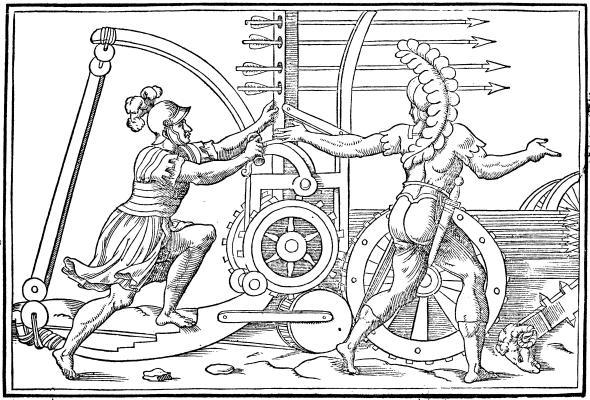This question originally appeared on Quora, the knowledge-sharing network where compelling questions are answered by people with unique insights. You can follow Quora on Twitter, Facebook, and Google Plus.
Answer by Eric Lowe, classics major and historical European martial arts instructor:
A trebuchet is a device for attacking fortifications. Roughly speaking, a trebuchet has a few advantages over a catapult. First, it can handle heavier projectiles. A catapult’s maximum weight tops out at about 180 pounds; trebuchets top out at about 350. Second, compared with a torsion engine, it’s a fairly robust machine. Lastly, for a given weight of stone, the trebuchet has a longer range. The big ones there, of course, are the maximum projectile weight and range. When your objective is to smash stone fortifications, being able to throw bigger stones from farther away is certainly a desirable trait.
A catapult—well, we need to sort of redefine your idea of what a catapult is.
“Catapult” itself means shield-piercer. The things were originally designed to project darts of a size that no bow could shoot, with a range that no bow could match. The common thread among the three engines I illustrated is what’s called the “torsion spring,” the twisted skein of animal sinew that you see the arms stuck into. You can get a low-power demonstration of the idea by placing a pencil into the loop of a rubber band and then twisting the rubber band; when you let go, the twisted skein of rubber band makes the pencil whip around. That principle, writ large, is how a catapult works.
It’s important to note, therefore, that catapults do more things than trebuchets do. They were frighteningly accurate, as both ancient sources and modern reconstructions attest. Dart-throwing catapults were, I kid you not, used to snipe individual soldiers off of fortification walls from far beyond bowshot (the longest range attested for a dart-thrower is 700 yards; the longest achieved by modern reconstructions something like 400—still way beyond the effective range of any bow ever made). You can imagine how accurate, long-range anti-personnel fire could be quite useful in a siege, both to suppress defenders and simply to demoralize them. This is a capability that a trebuchet simply does not have. This is also why I list range as only a half advantage of a catapult. Because “catapult” covers a fairly wide range of machines, it’s accurate to say that trebuchets have a longer range than a catapult when projecting stones at fortifications. When it comes to the maximum range of any catapult, ever, catapults definitely have trebuchets beat. Then again, trebuchets don’t shoot darts, so the whole comparison is kind of wonky.
Now, when it comes to stone-throwing catapults, whether of the two-armed or one-armed variety, those are basically inferior to trebuchets. The one real advantage that they have is not tactical but strategic: Trebuchets require an incredible amount of wood. You just can’t take trebuchets with you on campaign, even disassembled, without the most extraordinary feats of logistics. Catapults, by comparison, are relatively portable (emphasis on the “by comparison”; a stone-throwing catapult can easily weigh upward of 2 tons). On the other hand, trebuchets only really require wood. The real guts of a catapult—the torsion springs—require the deaths of a great many cattle to provide the necessary sinew. In that sense, trebuchets are fairly cheap (assuming you’re campaigning in a part of the world where wood is abundant). On top of that, because the springiness of the torsion springs is highly sensitive to factors such as humidity, the springs require constant adjustment to maintain performance. You can imagine what it would do to accuracy if the right spring is ever so slightly looser than the left spring, and even if you’re using a one-armed catapult, you need to pay close attention to whether the spring needs to be wound tighter or looser to maintain the same point of aim. The things are heavy; you can’t just pick them up and move them if you find out that you’re hitting 50 yards short because it rained yesterday.
Speaking of movement: You can’t put one-armed catapults on wheels. I mean, you can, but if the machine has any power at all, the recoil will cause the whole frame to jump into the air a bit when it shoots, and then slam down (and remember, these things weigh thousands of pounds). That will quickly smash your wheels to bits. The normal thing to do was to place them on bales of hay to act as shock absorbers. The hay bales would themselves be pounded to bits eventually, but you can re-bale the hay a lot more easily than you can fix a cracked catapult frame.
Two-armed catapults could be put on wheels, sort of. Dart-throwers were put on carts, and evidently shot from carts, in various cultures and times. And it was also fairly common to place them in siege towers. Likewise, stone-throwing catapults were not infrequently placed in siege towers. Now, a siege tower is not a small structure. But they are technically mobile.
Trebuchets, because they don’t recoil in the same way as catapults, can be put on wheels. In fact, doing so is advantageous for their accuracy, as I understand it, because of the way it lets the whole machine absorb some of the forces involved. On the other hand, owing to how incredibly large trebuchets were, you still couldn’t pre-assemble them and take them with you on campaign.
What are the tactical advantages of a trebuchet over a catapult and vice versa? originally appeared on Quora. More questions on Quora:
